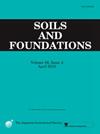Investigation on the lateral performance of new piles in sand sites containing existing piles and shallow cement-treated backfill
IF 3.3
2区 工程技术
Q2 ENGINEERING, GEOLOGICAL
引用次数: 0
Abstract
Piles are extensively utilized as the foundation to support buildings, bridges, and other superstructures subjected to lateral loads. The lateral load-bearing performance of newly installed piles in sites with existing piles is inevitably influenced by the presence of existing piles due to the interactions between the new pile, soil, and existing piles. Conversely, the lateral capacity of new piles can be significantly enhanced by effectively regulating these interactions. This study quantified the effect of shallow cement improvement on laterally loaded new piles in sand sites containing existing piles and shallow cement-treated backfill for different variables. A numerical model of new pile-soil-existing pile interactions under lateral loads was initially validated against 40 g centrifuge tests in density sand. Subsequent analyses incorporating shallow cement-treated backfill explored the lateral bearing mechanism of new piles and the corresponding response of existing piles. The findings indicate that cement-treated backfill can substantially enhance the lateral capacity of new piles for ultimate limit state (ULS) design limit by two times, compared with the condition without cement-treated backfill. With the increase of the depth of the new pile embedded in the cap, the thickness and modulus of the cement-treated backfill, the lateral capacity of the new pile increases. However, the depth of the existing pile embedded in the backfill has a limited influence on new pile capacity. Finally, a practical method for assessing lateral new pile capacities in sand sites containing existing piles and shallow cement-treated backfill was developed, demonstrating considerable advantages in designing laterally loaded new piles considering shallow cement improvement.
既有桩与浅层水泥处理充填体的砂场地新桩横向性能研究
桩被广泛用作支撑建筑物、桥梁和其他承受横向荷载的上层结构的基础。在已有桩的场地上,由于新桩与土、已有桩的相互作用,新桩的横向承载性能不可避免地会受到已有桩存在的影响。相反,通过有效调节这些相互作用,可以显著提高新桩的抗侧承载力。本研究量化了不同变量下浅层水泥改善对既有桩和浅层水泥处理回填体的砂场地横向加载新桩的影响。在密度砂土中进行了40g离心试验,初步验证了侧向荷载作用下新桩-土-既有桩相互作用的数值模型。随后的分析结合浅层水泥处理回填体探讨了新桩的横向承载机制和现有桩的相应响应。研究结果表明:与未加水泥处理的情况相比,水泥处理后的新桩在达到极限状态(ULS)设计极限时的抗侧承载力提高了2倍;随着新桩嵌入承台深度的增加、水泥处理充填体的厚度和模量的增加,新桩的侧承载力增大。然而,现有桩嵌入回填体的深度对新桩承载力的影响有限。最后,开发了一种实用的方法来评估含有现有桩和浅水泥处理回填体的砂场地的横向新桩承载力,在设计考虑浅水泥改善的横向加载新桩方面具有相当大的优势。
本文章由计算机程序翻译,如有差异,请以英文原文为准。
求助全文
约1分钟内获得全文
求助全文
来源期刊

Soils and Foundations
工程技术-地球科学综合
CiteScore
6.40
自引率
8.10%
发文量
99
审稿时长
5 months
期刊介绍:
Soils and Foundations is one of the leading journals in the field of soil mechanics and geotechnical engineering. It is the official journal of the Japanese Geotechnical Society (JGS)., The journal publishes a variety of original research paper, technical reports, technical notes, as well as the state-of-the-art reports upon invitation by the Editor, in the fields of soil and rock mechanics, geotechnical engineering, and environmental geotechnics. Since the publication of Volume 1, No.1 issue in June 1960, Soils and Foundations will celebrate the 60th anniversary in the year of 2020.
Soils and Foundations welcomes theoretical as well as practical work associated with the aforementioned field(s). Case studies that describe the original and interdisciplinary work applicable to geotechnical engineering are particularly encouraged. Discussions to each of the published articles are also welcomed in order to provide an avenue in which opinions of peers may be fed back or exchanged. In providing latest expertise on a specific topic, one issue out of six per year on average was allocated to include selected papers from the International Symposia which were held in Japan as well as overseas.
 求助内容:
求助内容: 应助结果提醒方式:
应助结果提醒方式:


